In this post, I’ll explain when to replace bicycle tyres, how to tell they are due for replacement and what to look out for related to tyre wear and replacement. A separate post explains how to mount (and dismount) a bicycle tyre.
Table Of Contents (T.O.C.):
- Introduction
- Tyre ageing
2.1. What is tyre ageing?
2.2. What affects tyre ageing?
2.3. Aged tyre examples – how to tell?
2.4. Consequences (risks) of tyre ageing - Tyre wear
3.1. What is tyre wear?
3.2. What affects tyre wear?
3.3. How to tell a tyre is worn?
3.4. Consequences of tyre wear - Common mistakes – like swapping front and rear tyres
- When to replace a bicycle tyre?
- Conclusion
- Video showing a tyre fit for replacement
1. Introduction
When reading some tyre manufacturer instructions, it seems as though we should cover the Earth with (un)worn tyres, and as though we are all millionaires, throwing away tyres as soon as we get a flat. OK, I am exaggerating, but not too much – the recommendations are rather “strict”, probably in order to prevent anyone from suing the companies in case of any problems.
Speaking of liability, I must say that all the info and advice given here is based on my knowledge and experience, but you are following them at your own risk. It has served me well for decades, I’m as convinced as I can be that it is a safe way to do it, but can’t guarantee anything to anyone, of course.
Briefly put, tyres need replacing when they are too old, or too worn (one not excluding the other).
To start, before explaining the tyre wear, I will explain tyre ageing.
2. Tyre ageing
2.1. What is tyre ageing?
Tyres have certain properties: elasticity, grip (as opposed to being “plastic”), shape etc. Tyre aging is the loss of these properties’ quality over a period of time – due to time, not (just) because of wear.
In appropriate storage conditions (temperature, humidity etc.) tyres can last for a decade, without any notable ageing. Ageing, as an important factor, starts once a tyre is mounted.
2.2. What affects tyre ageing?
When discussing factors that affect tyre aging, I will mention the perfect conditions. Of course, tyres should serve you, not the other way round, so compromise is often necessary. However, knowing the perfect conditions is good as an ideal to strive for, in situations when it is possible and convenient to choose – so that you can choose what’s better for the tyres. I’ll numerate all the factors, for easier reference:
1. Pressure
As soon as a tyre is mounted and inflated, the air pressure tries to tear the tyre’s carcass (for more details, see tyre sidewall and rubber compound quality). The higher the pressure, the more tyre’s carcass is put under stress and the faster a tyre ages. This is one of the reasons for inflating tyres to the optimal pressure (not too high, and not too low).
If a bicycle is stored for a longer period, it’s not a bad idea to have the pressure lower than optimal, just make sure the tyres are not “squashed”, because they could get deformed over time if left like that. Likewise, if a bicycle with a flat tyre is pushed for as little as several hundreds of meters, tyre sidewalls could crack.
Riding with a pressure much lower than the optimal can drastically increase tyre sidewall ageing and cracking. Naturally, too high a pressure should definitely be avoided as well.
2. Air
Tyres oxidize in the air. It is ideal to store a bicycle indoors, at a moderate temperature (between 15 and 25 °C). Freezing, or very hot temperatures, or storing near a heater, all speed up tyre ageing. They can be wrapped in nylon when stored, but only if they are completely dry and stored at room temperature, to avoid rotting from moisture and condensation.
Bare concrete also pulls moisture out of the tyres and can cause them to dry-rot. Put some cardboard, or old carpet under the wheels if a bicycle is stored on concrete.
3. Sunshine
Direct sunlight, especially when it’s summer (hot) and if it is prolonged, can cause tyres to quickly age and crack.
4. Salty water
Often present during winter cycling, at least in my country where ice on the roads is often suppressed by throwing salt on the pavement. Salty water makes the tyre sidewall fabric rot and crack. In my experience, good quality bicycle winter tyres are more resistant to this factor, than the “ordinary” tyres.
2.3. Aged tyre examples – how to tell?
Pictures are worth a 1000 words:

Picture 1
If a tyre is of low quality, or stored on bare concrete, or inflated to pressure too high, or left in direct sunlight, it can happen for the tread to crack while the sidewalls are still perfectly fine:
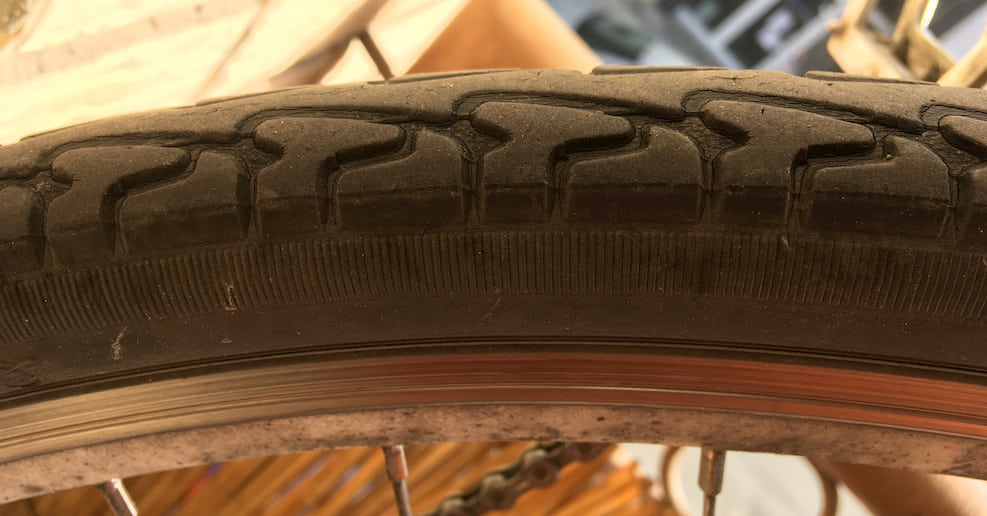
Picture 2
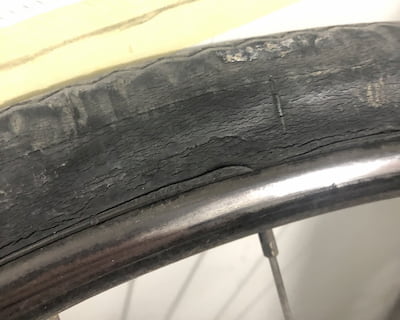
Picture 3
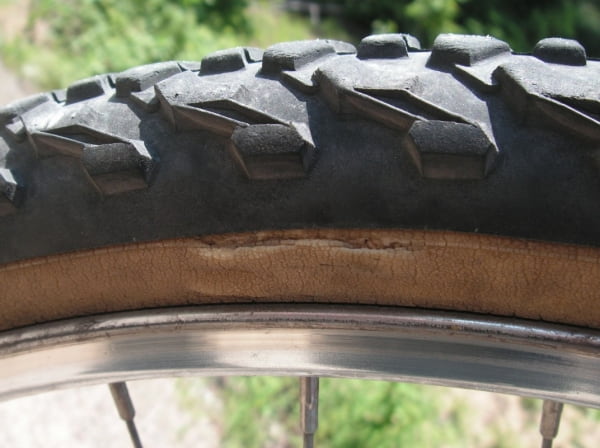
Picture 4
another sign of a cracked tyre carcass is the appearance of one, or several bulges when the tyre is inflated. They look like a small hunch, a small “egg” under the rubber. Such tyre will burst at that place sooner, or later. It has to be replaced.
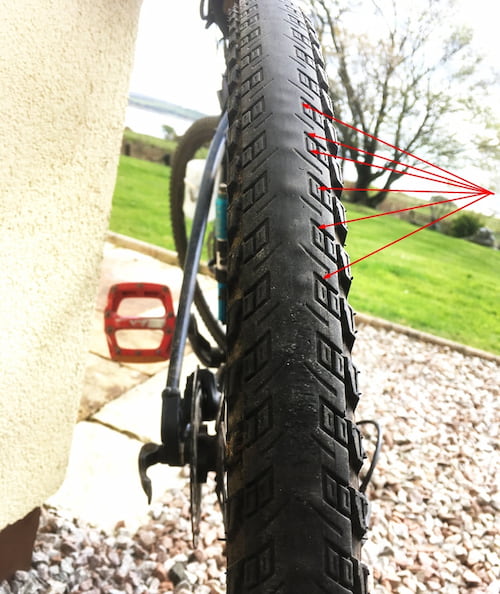
source: an Ask a Bicycle Mechanic Facebook group member
Picture 5
The tyre in the picture above has several smaller bulges. A more common scenario is one larger bulge, often on a side of the tyre.
In addition to visual inspection, tyre grip, especially on pavement, is a good indicator of ageing – aged tyres grip a lot worse, especially in the wet. Testing (under controlled conditions and at low speeds – to avoid premature wear and accidents) how much it takes for a rear tyre to lose grip under braking and start skidding – then comparing that (from memory?) with a new tyre. Doing this with the front tyre is a bit riskier – skidding of the front wheel can cause a sudden and uncontrolled fall to the ground. So visual inspection is the most reliable and safest method of checking the tyres for ageing.
2.4. Consequences (risks) of tyre ageing
Aged tyres will not grip as well, especially in the wet (the more aged a tyre is, the more can the difference between its dry and wet grip be pronounced).
Also, tyres with cracked sidewalls (as shown in pictures 1 to 5) can suddenly, without prior notice, blow out, perhaps in the middle of a ride, or a turn during a descent.
3. Tyre wear
3.1. What is tyre wear?
This is physical tyre material wear due to use, of course.
3.2. What affects tyre wear?
Obviously, use affects tyre wear, but here are some factors and use cases that make the most difference:
1. Surface
The rougher the surface, the faster tyres wear. Not every mountain path and not even every pavement is created equal. Some are rougher, others smoother. Rougher pavement helps better grip, especially in turns and in the rain, but it wears the tyres faster.
2. Climbs
Riding up hills wears the rear tyre a lot faster than riding in the plains.
3. Driving torque
Tyres of the driving wheels (with bicycles it is usually the rear wheel) wear a lot faster.
4. Weight
The more weight a wheel carries, the faster its tyre wears. For most “ordinary” bicycles, the rear tyre carries more weight.
5. Braking
Braking increases tyre wear. With bicycles, the most braking force is achieved using the front tyre (bicycle braking technique). However, because the rear wheel gets unloaded when braking hard (and because of bad habits, and/or poor braking technique), it can often happen that the rear wheel starts skidding on the surface / pavement, making a screeching sound. This excessively increases tyre wear.
For example, with road bicycle tyres, coming to a full stop on a descent, from about 50 km/h speed, if using only the rear brake and blocking the rear wheel so that the tyre skids, one such brake is enough to completely wear a new tyre, all the way down to cords.
6. Impacts
One bad pothole can completely cut through the tyre (even damaging the rim).
3.3. How to tell a tyre is worn?
For knobby tyres, or any tyres with a pronounced tread, it is clearly visible when the tread gets worn. It can also be noticed by poorer grip in the mud. Grip on the pavement is improved the balder a tyre is (see the post about slick bicycle tyres)!
For pavement tyres, that have shallow tread, or (almost) no tread at all, the story is a bit different:
Many manufacturers, especially of higher quality road bicycle tyres, make “tyre wear indicators”. Here’s what it looks like on Continental tyres:
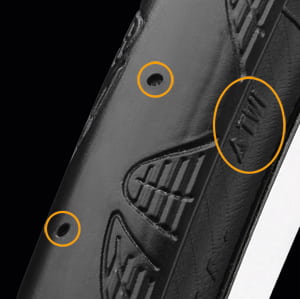
source: conti-tyres.co.uk
Picture 6
Once the tyre wear indicators are worn (they “disappear”), the tyre is considered worn and should be replaced.
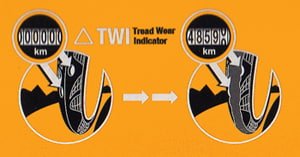
source: conti-tyres.co.uk
Picture 7

Picture 8
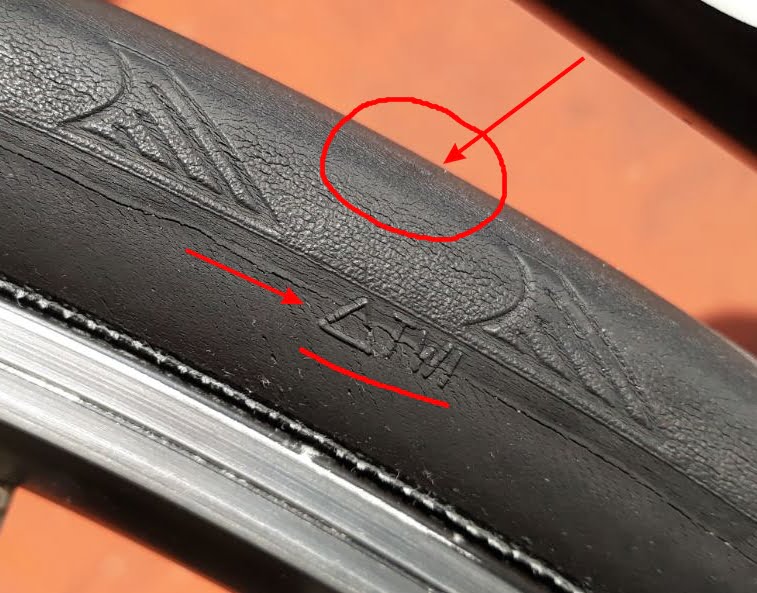
Picture 9

Picture 10
Some tyres don’t have such indicators, but have a differently coloured (protective) inner layer:
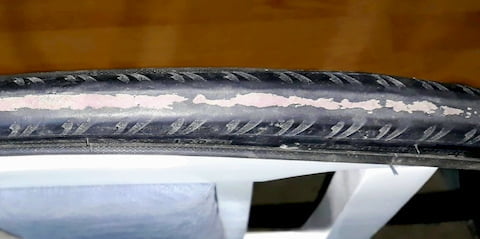
Picture 11
Another way of determining road bike tyre wear is when threads are shown – usually on the tread, the middle section that goes over the pavement. Worn to the threads = replace:

Picture 12
3.4. Consequences of tyre wear
With off-road tyres, the most notable effect of wear is worse grip in the mud (with a better grip on the pavement, especially in the rain).
For road bicycle tyres, the first notable effect is easier and more frequent punctures – because the tyre material is thinned down. This goes especially for the rear tyres (I’ll write when I find the time why rear tyres get more punctures). If a tyre isn’t replaced in time, it can wear so much that it just blows out, suddenly.
4. Common mistakes – like swapping front and rear tyres
In the chapters about tyre ageing and tyre wear, I explained how they lose properties and are more likely to blow out as they age and/or wear. I also explained how and why the rear tyre usually gets “done” faster than the front one.
Because of rear tyre’s faster wear, many people swap tyres, placing the (almost completely) worn rear tyre to the front and the front tyre to the rear wheel. If touring where you can’t find any new tyres, this can help. But, if it is possible, this should be avoided. Why?
Front wheel is crucial for controlling a bicycle and staying upright (see my post about counter-steering). Getting a flat front tyre, especially at speed, can be dangerous.
This is why my advice is: new tyre goes on the front wheel, while the old one can be moved from the front wheel to the rear. But never put a more worn tyre on the front.
Another common mistake is riding with severely aged tyres. This is especially risky with the front tyres.
Less often, people change tyres that are still good after two years, because “it says so in the manufacturer’s manual”. This hurts your pocket and pollutes the planet.
5. When to replace a bicycle tyre?
If you’ve read the previous chapters, you probably know the answer: when it is too aged, or worn.
If you don’t ride fast downhill, you could risk it with the rear tyre, but never with the front one, even for slow riding in the flat lands – at least in my opinion.
6. Conclusion
Keep an eye on your tyres – it is what keeps you upright when cycling. Those two small contact patches.
Regularly check the tyre pressure.
I’d like to thank everyone whose photos contributed to making this post. You rock! 🙂 In my experience, the cycling community is full of solidary people willing to help. Just as I hope this post will help others.
7. Video showing a tyre fit for replacement
I’ve made a video showing how a tyre with cracked sidewalls can cause a wheel to run out of true, and what a cracked tyre sidewalls look like:
Last updated:
Originally published:


Maybe worth adding that rear tyres may/will experience short skidding when the rear brake is over applied. This means that many rear tyres will exhibit short (5cm?) sections of their tread which is more worn than the rest. So even if the TWI is still present/evident, the complete circumference of the tyre merits regular examination (?weekly/every 500km?) particularly as the tyre gets older.
Yes, it is worth mentioning. I tried to explain it in chapter “3.2. What affects the tyre wear?” under point 5. “Braking”.
Suppose a photo would best demonstrate the “phenomena”.
i am having trouble finding a good durable tyre with reasonable puncture protection,i am looking for a 700×25 smooth tyre no tread clincher type,i tried maxxis refuse tires but they were just to heavy and way too hard to install,most race tyres are just too light with little puncture protection,looking for a smooth tire about 240 grams with around 125 tpi,michelin pro 4 endurance tyres come close but i cant even find those for sale.